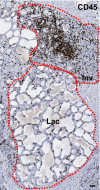Pregnancy and breast cancer: when they collide
- PMID: 19381788
- PMCID: PMC2693784
- DOI: 10.1007/s10911-009-9119-7
Pregnancy and breast cancer: when they collide
Abstract
Women of childbearing age experience an increased breast cancer risk associated with a completed pregnancy. For younger women, this increase in breast cancer risk is transient and within a decade after parturition a cross over effect results in an ultimate protective benefit. The post-partum peak of increased risk is greater in women with advanced maternal age. Further, their lifetime risk for developing breast cancer remains elevated for many years, with the cross over to protection occurring decades later or not at all. Breast cancers diagnosed during pregnancy and within a number of years post-partum are termed pregnancy-associated or PABC. Contrary to popular belief, PABC is not a rare disease and could affect up to 40,000 women in 2009. The collision between pregnancy and breast cancer puts women in a fear-invoking paradox of their own health, their pregnancy, and the outcomes for both. We propose two distinct subtypes of PABC: breast cancer diagnosed during pregnancy and breast cancer diagnosed post-partum. This distinction is important because emerging epidemiologic data highlights worsened outcomes specific to post-partum cases. We reported that post-partum breast involution may be responsible for the increased metastatic potential of post-partum PABC. Increased awareness and detection, rationally aggressive treatment, and enhanced understanding of the mechanisms are imperative steps toward improving the prognosis for PABC. If we determine the mechanisms by which involution promotes metastasis of PABC, the post-partum period can be a window of opportunity for intervention strategies.
Figures


References
-
- {'text': '', 'ref_index': 1, 'ids': [{'type': 'DOI', 'value': '10.1056/NEJM199407073310102', 'is_inner': False, 'url': 'https://doi.org/10.1056/nejm199407073310102'}, {'type': 'PubMed', 'value': '8202106', 'is_inner': True, 'url': 'https://pubmed.ncbi.nlm.nih.gov/8202106/'}]}
- Lambe M, Hsieh C, Trichopoulos D, Ekbom A, Pavia M, Adami HO. Transient increase in the risk of breast cancer after giving birth. N Engl J Med. 1994;331(1):5–9. doi:10.1056/NEJM199407073310102. - PubMed
-
- {'text': '', 'ref_index': 1, 'ids': [{'type': 'DOI', 'value': '10.1038/sj.bjc.6602302', 'is_inner': False, 'url': 'https://doi.org/10.1038/sj.bjc.6602302'}, {'type': 'PMC', 'value': 'PMC2361726', 'is_inner': False, 'url': 'https://pmc.ncbi.nlm.nih.gov/articles/PMC2361726/'}, {'type': 'PubMed', 'value': '15597097', 'is_inner': True, 'url': 'https://pubmed.ncbi.nlm.nih.gov/15597097/'}]}
- Albrektsen G, Heuch I, Hansen S, Kvale G. Breast cancer risk by age at birth, time since birth and time intervals between births: exploring interaction effects. Br J Cancer. 2005;92(1):167–75. doi:10.1038/sj.bjc.6602302. - PMC - PubMed
-
- {'text': '', 'ref_index': 1, 'ids': [{'type': 'PubMed', 'value': '10752799', 'is_inner': True, 'url': 'https://pubmed.ncbi.nlm.nih.gov/10752799/'}]}
- Chie WC, Hsieh C, Newcomb PA, Longnecker MP, Mittendorf R, Greenberg ER, et al. Age at any full-term pregnancy and breast cancer risk. Am J Epidemiol. 2000;151(7):715–22. - PubMed
-
- {'text': '', 'ref_index': 1, 'ids': [{'type': 'PubMed', 'value': '12074499', 'is_inner': True, 'url': 'https://pubmed.ncbi.nlm.nih.gov/12074499/'}]}
- Liu Q, Wuu J, Lambe M, Hsieh SF, Ekbom A, Hsieh CC. Transient increase in breast cancer risk after giving birth: postpartum period with the highest risk (Sweden). CCC. 2002;13(4):299–305. doi:10.1023/A:1015287208222. - PubMed
-
- {'text': '', 'ref_index': 1, 'ids': [{'type': 'PubMed', 'value': '3565352', 'is_inner': True, 'url': 'https://pubmed.ncbi.nlm.nih.gov/3565352/'}]}
- Dupont WD, Page DL. Breast cancer risk associated with proliferative disease, age at first birth, and a family history of breast cancer. Am J Epidemiol. 1987;125(5):769–79. - PubMed
Publication types
MeSH terms
Substances
LinkOut - more resources
Full Text Sources
Medical

